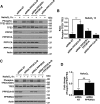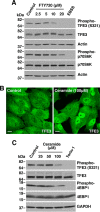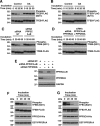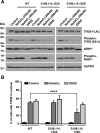Protein phosphatase 2A stimulates activation of TFEB and TFE3 transcription factors in response to oxidative stress
- PMID: 29945972
- PMCID: PMC6093222
- DOI: 10.1074/jbc.RA118.003471
Protein phosphatase 2A stimulates activation of TFEB and TFE3 transcription factors in response to oxidative stress
Abstract
Adaptations and responses to stress conditions are fundamental processes that all cells must accomplish to maintain or restore cellular homeostasis. Cells have a plethora of response pathways to mitigate the effect of different environmental stressors. The transcriptional regulators transcription factor EB (TFEB) and transcription factor binding to IGHM enhancer 3 (TFE3) play a key role in the control of these stress pathways. Therefore, understanding their regulation under different stress conditions is of great interest. Here, using a range of human and murine cells, we show that TFEB and TFE3 are activated upon induction of acute oxidative stress by sodium arsenite via an mTOR complex 1 (mTORC1)-independent process. We found that the mechanism of arsenite-stimulated TFEB and TFE3 activation instead involves protein phosphatase 2A (PP2A)-mediated dephosphorylation at Ser-211 and Ser-321, respectively. Depletion of either the catalytic (PPP2CA+B) or regulatory (PPP2R2A/B55α) subunits of PP2A, as well as PP2A inactivation with the specific inhibitor okadaic acid, abolished TFEB and TFE3 activation in response to sodium arsenite. Conversely, PP2A activation by ceramide or the sphingosine-like compound FTY720 was sufficient to induce TFE3 nuclear translocation. MS analysis revealed that PP2A dephosphorylates TFEB at several residues, including Ser-109, Ser-114, Ser-122, and Ser-211, thus facilitating TFEB activation. Overall, this work identifies a critical mechanism that activates TFEB and TFE3 without turning off mTORC1 activity. We propose that this mechanism may enable some cell types such as immune or cancer cells that require simultaneous TFEB/TFE3 and mTORC1 signaling to survive and achieve robust cell growth in stressful environments.
Keywords: mTORC1; nuclear translocation; okadaic acid; oxidative stress; phosphatase; protein phosphatase 2 (PP2A); sodium arsenite; transcription factor; transcription factor EB; transcription factor binding to IGHM enhancer 3.
Conflict of interest statement
The authors declare that they have no conflicts of interest with the contents of this article
Figures







Similar articles
-
AMPK-dependent phosphorylation is required for transcriptional activation of TFEB and TFE3.Autophagy. 2021 Dec;17(12):3957-3975. doi: 10.1080/15548627.2021.1898748. Epub 2021 Mar 18. Autophagy. 2021. PMID: 33734022 Free PMC article.
-
Phosphorylation of EIF2S1 (eukaryotic translation initiation factor 2 subunit alpha) is indispensable for nuclear translocation of TFEB and TFE3 during ER stress.Autophagy. 2023 Jul;19(7):2111-2142. doi: 10.1080/15548627.2023.2173900. Epub 2023 Feb 9. Autophagy. 2023. PMID: 36719671 Free PMC article.
-
The FACT complex facilitates expression of lysosomal and antioxidant genes through binding to TFEB and TFE3.Autophagy. 2022 Oct;18(10):2333-2349. doi: 10.1080/15548627.2022.2029671. Epub 2022 Mar 1. Autophagy. 2022. PMID: 35230915 Free PMC article.
-
Transcription factor EB and TFE3: new metabolic coordinators mediating adaptive responses to exercise in skeletal muscle?Am J Physiol Endocrinol Metab. 2020 Oct 1;319(4):E763-E768. doi: 10.1152/ajpendo.00339.2020. Epub 2020 Aug 24. Am J Physiol Endocrinol Metab. 2020. PMID: 32830550 Review.
-
The Spectrum of Renal "TFEopathies": Flipping the mTOR Switch in Renal Tumorigenesis.Physiology (Bethesda). 2024 Nov 1;39(6):0. doi: 10.1152/physiol.00026.2024. Epub 2024 Jul 16. Physiology (Bethesda). 2024. PMID: 39012319 Review.
Cited by
-
The Oncogene Transcription Factor EB Regulates Vascular Functions.Front Physiol. 2021 Apr 12;12:640061. doi: 10.3389/fphys.2021.640061. eCollection 2021. Front Physiol. 2021. PMID: 33912071 Free PMC article. Review.
-
Enhancement of lysosome biogenesis as a potential therapeutic approach for neurodegenerative diseases.Neural Regen Res. 2023 Nov;18(11):2370-2376. doi: 10.4103/1673-5374.371346. Neural Regen Res. 2023. PMID: 37282455 Free PMC article.
-
The transcription factors Tfeb and Tfe3 are required for survival and embryonic development of pancreas and liver in zebrafish.PLoS Genet. 2025 Jun 27;21(6):e1011754. doi: 10.1371/journal.pgen.1011754. eCollection 2025 Jun. PLoS Genet. 2025. PMID: 40577485 Free PMC article.
-
Metabolic stress induces a double-positive feedback loop between AMPK and SQSTM1/p62 conferring dual activation of AMPK and NFE2L2/NRF2 to synergize antioxidant defense.Autophagy. 2024 Nov;20(11):2490-2510. doi: 10.1080/15548627.2024.2374692. Epub 2024 Jul 10. Autophagy. 2024. PMID: 38953310 Free PMC article.
-
More than just a garbage can: emerging roles of the lysosome as an anabolic organelle in skeletal muscle.Am J Physiol Cell Physiol. 2020 Sep 1;319(3):C561-C568. doi: 10.1152/ajpcell.00241.2020. Epub 2020 Jul 29. Am J Physiol Cell Physiol. 2020. PMID: 32726158 Free PMC article. Review.
References
-
- Sardiello M., Palmieri M., di Ronza A., Medina D. L., Valenza M., Gennarino V. A., Di Malta C., Donaudy F., Embrione V., Polishchuk R. S., Banfi S., Parenti G., Cattaneo E., and Ballabio A. (2009) A gene network regulating lysosomal biogenesis and function. Science 325, 473–477 10.1126/science.1174447 - DOI - PubMed
Publication types
MeSH terms
Substances
LinkOut - more resources
Full Text Sources
Other Literature Sources
Molecular Biology Databases
Research Materials
Miscellaneous

